#network software assignment help
Explore tagged Tumblr posts
Text
MANAGEMENT PROGRAMS
A graduate-level program called the Master of Business Administration (MBA) equips students with enhanced knowledge and abilities in business and management. For people hoping to hold administrative and leadership positions across a range of sectors, this is one of the most sought-after degrees. A typical MBA program offers possibilities for specialization in several business disciplines in addition to covering a wide variety of topics.
Essential Elements of an MBA Curriculum:
Fundamental Curriculum:
Finance: Gaining knowledge about corporate finance, investment techniques, and financial management.
Marketing: Acquiring knowledge about market research, branding, and customer behavior.
Supply chains, logistics, and production processes are all managed by operations managers.
Accounting includes cost control, financial reporting, and auditing.
Economics: The study of macro- and microeconomics in relation to business choices.
Strategy: Creating long-term plans and competing strategies.
Organizational behavior is the study of how people act both individually and in groups inside an organization.
Leadership and Ethics: emphasizing corporate social responsibility, moral decision-making, and leadership philosophies.
Elective Courses and Specializations: Students can select electives to focus on a variety of topics, including technology management, international business, finance, marketing, entrepreneurship, and human resources.
Capstone Projects and Internships: A capstone project or internship is a requirement of many MBA programs. It allows students to apply their academic knowledge to real-world business problems, frequently working in collaboration with businesses.
Opportunities for Networking: MBA schools offer a wealth of opportunities for networking with instructors, alumni, peers, and business professionals. These connections can be helpful for advancing one's career.
Case studies are a popular teaching technique in MBA programs where students examine actual business situations and brainstorm possible fixes.
Development of Soft Skills: Communication, negotiation, leadership, and teamwork are prioritized.

MBA Program Types:
Full-Time MBA: Usually a one to two-year program intended for individuals able to devote themselves to studying full-time. People who are just starting out in their jobs or who want to make a big professional move frequently pursue it.
Part-Time MBA: Designed for professionals in the workforce who wish to continue their education while they work. Weekends and nights are common times for classes to be offered.
The Executive MBA program is designed for seasoned professionals (often with over a decade of experience) who aspire to progress into higher-level leadership positions. High-level strategic management is the main emphasis of the usually part-time programs.
Online MBA: Provides students with the option to finish their degree at their own pace. For people who need to balance, it is perfect.
The Global MBA program focuses on worldwide business and may provide study abroad options or collaborations with multinational organizations.
#management education in india#management system#innovation#technology#outsourcing#strategies#management assignment help#management consulting services#networking#management software
1 note
·
View note
Text
Oh man. Now I'm crying.
I'm very comfortable setting hardware standards for desktops and laptops, I'm very comfortable sourcing servers and getting the parts and software that they need to be configured, I am *not* comfortable being asked to build tech infrastructure to meet the clients' needs when I'm not familiar with their networks, business, or utilization.
That IS an unreasonable thing to have assigned to me and no wonder I kept getting stressed out looking at those tickets.
Anyway I have now messaged my coworker (former VP of operations at old job who is now one of our very few level three techs and who is the supervisor of our new networking team) "hello! I need help! please help me I can't quote these alone" and I'm crying and I feel much better.
What a stupid way to get catharsis.
(the firewall is not just the firewall! you have to consider throughput and what APs it will be networked with and ease of use for the consultants and cost of licenses over multiple years - will this be compatible with their setup? I literally don't have the first clue how to figure that out and I don't want to be the one who recommends a piece of hardware that means they have to replace three other pieces of hardware because I didn't know it didn't support some standard or another! That is a job for someone who is actually technical!)
535 notes
·
View notes
Text
Edward Coristine, a 19-year-old engineer with Elon Musk’s so-called Department of Government Efficiency (DOGE) known as “Big Balls,” is now on staff at the Cybersecurity and Infrastructure Security Agency (CISA), WIRED has confirmed. He is joined by another member of the DOGE team, 38-year-old software engineer Kyle Schutt, who is now also on the CISA staff, according to a government source.
CISA referred WIRED to the Department of Homeland Security (DHS), of which it’s a component agency, when reached for comment. DHS did not immediately reply to a request for comment.
Coristine—briefly an intern for Musk’s brain-computer interface company, Neuralink, as WIRED has reported—has been working his way through numerous federal agencies and departments as a DOGE operative since January. He has been tracked at the General Services Administration (GSA), the Office of Personnel Management, the State Department, and FEMA. At State’s Bureau of Diplomatic Technology, he potentially had access to systems containing sensitive information about diplomats and many sources and spies around the world who provide the U.S. government with intelligence and expertise.
As the journalist Marisa Kabas was first to report, he has now moved to CISA, a division of DHS. He is listed in the staff directory as a senior advisor.
A second DOGE worker, Schutt, has also joined Coristine at CISA. Schutt has reportedly also been at the GSA. Prior to his work with DOGE, he worked on the launch of WinRed, a fundraising platform for Republicans that helped the party raise $1.8 billion during the 2024 election campaigns.
It’s not clear yet what level of access Coristine might have to data and networks at CISA, but the agency, which is responsible for the defense of civilian federal government networks and works closely with critical infrastructure owners around the country, stores a lot of sensitive and critical security information on its networks. This includes information about software vulnerabilities, breaches, and network risk assessments conducted for local and state election offices. Since 2018, CISA has helped state and local election offices around the country assess vulnerabilities in their networks and help secure them. CISA also works with the Federal Bureau of Investigation and the National Security Agency to notify victims of breaches and process information about software vulnerabilities before the information becomes public.
Coristine, as WIRED has previously reported, worked briefly in 2022 for Path Network, a network monitoring firm known for hiring reformed blackhat hackers. According to security journalist Brian Krebs, an account once associated with him was also previously linked with a loosely-formed cybercriminal community known as The Com, whose members have been responsible for various hacking operations in the last few years, including the hack of numerous Snowflake accounts. Coristine has not been associated with the Snowflake breaches, but as WIRED has reported, an account that has been associated with him did appear to suggest the owner of the account was seeking help to conduct a Distributed Denial of Service attack—a criminal technique that involves launching extensive traffic at a domain to disable it and prevent legitimate traffic from reaching it. Krebs also reported that Path had fired Coristine for allegedly leaking internal company documents to a competitor.
The Washington Post reported last week that Coristine had been assigned to the DHS as a senior advisor, but didn’t indicate what part of the sprawling agency he had joined.
“What’s the point of fighting cybercrime if we’re just going to give access for government networks to people with cybercriminal gang affiliations?” says a cybersecurity researcher who tracks cybercriminal groups.
5 notes
·
View notes
Text

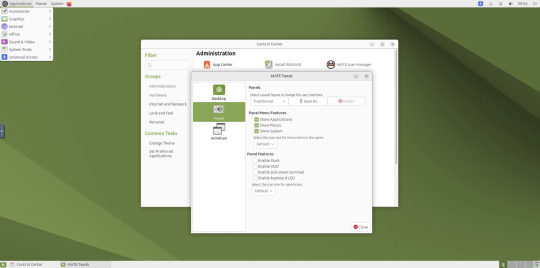
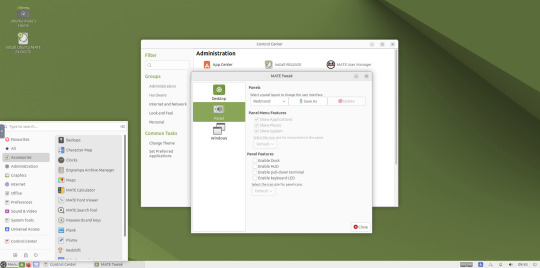
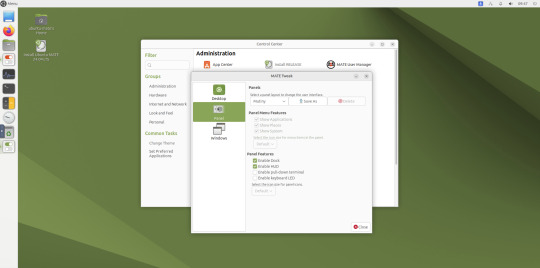
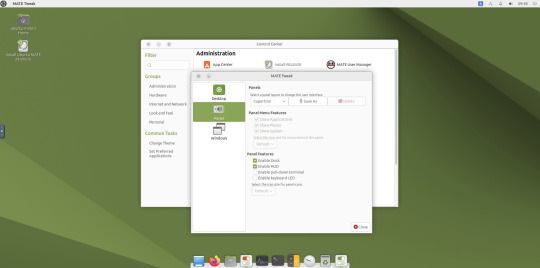
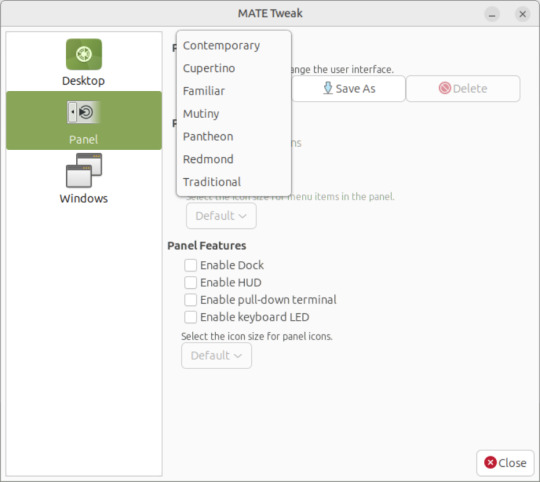
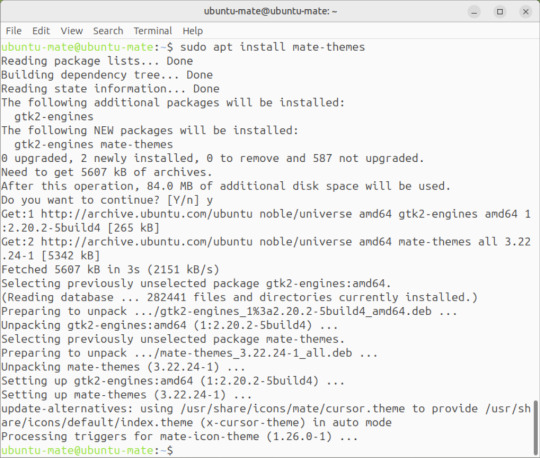




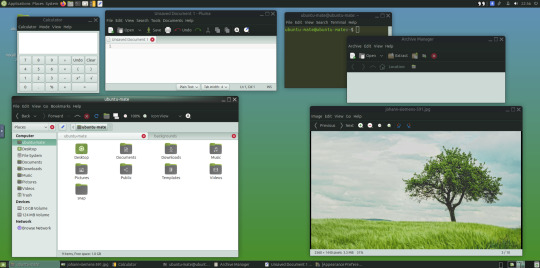
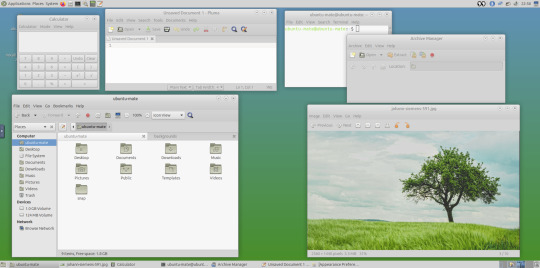






May 2025.
I tried installing a set of themes on Ubuntu MATE 24.04.1 LTS in Distrosea today.
https://distrosea.com/
These themes are provided as a theme package found in vanilla MATE desktops such as Debian and Fedora.
MATE is the modern day continuation of GNOME 2, a very popular, efficient and functional desktop environment from the early 2000s.
The theme pack I selected are compactable GTK3/4 (Graphical Toolkit) versions based on classic GNOME 2 era themes.
Ubuntu MATE website:
https://ubuntu-mate.org/
Debian Linux website:
https://www.debian.org/
Fedora Linux website:
https://fedoraproject.org/spins/mate
See MATE Desktop website here:
https://mate-desktop.org/blog/
About the Graphical Toolkit user interface:
https://en.wikipedia.org/wiki/GTK
I used the MATE Tweak tool to adjust the panels from the 'familiar' layout to the 'traditional' layout. Here are many of the layouts available.
MATE Tweak can change the panel layout between Traditional (GNOME 2), Unity, Redmond (Windows) contemporary (Mac OS) style.
Here are many of the layouts available.
Afterwards, I used the command line to install the themes with the command: sudo apt install mate-themes.
This command then prompted me to agree the system changes and then it installed the required theme files to the list.
I opened up the theme folder in the Caja file manager. This shows all the ones installed on the system.
Next I opened the appearance preferences and cycled through each theme. There are a total of 12 new themes it added alongside the existing Yaru Colour theme collection for Ubuntu.
This package couldn't be installed graphical so this is why I installed it through the terminal. It is also available to install through the Software Manager on Linux Mint.
The theme package can also be installed on the Cinnamon desktop and other linux distributions.
I like these themes as they provide a more 3D feel and is refreshing to see themes for a desktop environment that hasn't moved towards flat design. It themes all the desktop elements from the windows, panels, drop down menus, CSD apps and widgets.
My favourite one is called YaruOK (blue), as it provides resizable window controls, 3D controls and provides a familiar look to the desktop. The theme is also called TraditionalOK.
This theme is a fork of a GTK2 theme called Clear-looks, which was created by Red Hat developers.
YaruOK is a modern variant that uses GTK3 & 4. The theme is rendered in SVG instead of PNG format which improves HiDpi scaling and features themed client side decorations for header bar windows such as the Disks utility.
I also added a GNOME Eyes widget onto the panel!
These fun set of eyes follow your mouse cursor around the screen and can help you find the cursor amongst the clutter of windows. It is built to be very lightweight.
I also like the workspace switcher on the bottom left, which allows you to switch between as many desktop workspaces as you want.
The little square windows within each desktop can be clicked on and moved to another workspace.
Like with other desktop environments, you can also right click a window and move it onto another workspace. Each desktop can be named for a assigned task.
A System Monitor widget can also be added to the panels to display CPU, Memory, Swap and Network processes.
There are many other very interesting widget to play around with on the desktop and panels as well!
Here are the MATE themes in Ubuntu Linux 24.04.1, integrating with the Cinnamon desktop.
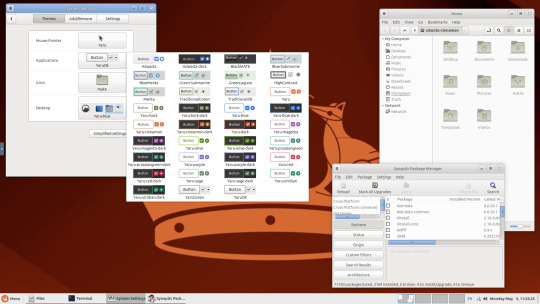


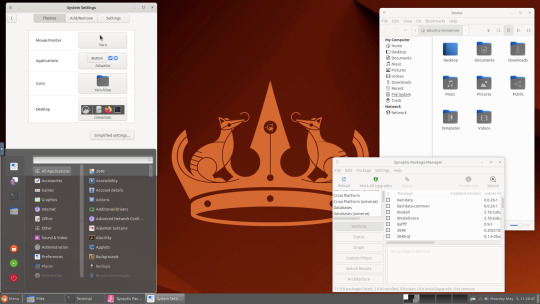
Below are some theming screenshots from Debian MATE 12 Linux.
I've customised the panel, selected the compact menu and changed notification sizes to make it more clearer. The window lists stack onto each other with the increased size.
The MATE panels have adjustable transparency and can be re-coloured and textured very easily through its own preferences box.
See screenshots below!


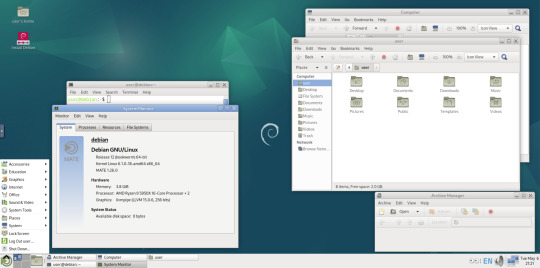

A very interesting look at the user interface elements found in GNOME 2, MATE and Cinnamon Linux desktop environments!
5 notes
·
View notes
Note
How is the process of learning In-house game engines once you get into an AAA studio? Do they immediately put you in production to learn as you go, or does it take some weeks before allocating you to a project?
The onboarding process is a little of everything you say. Whenever I start a new job, there's the new hire administrative tasks I need to get done like signing paperwork and doing harassment/DEI/office safety training and there's the actual "this is what they hired me to do" learning process where I learn how the workflow works so that I can start being productive. We'll ignore the administrative stuff and focus on the productivity onboarding.

The first thing that any new hire has to do is get the project synced to the latest safe build and get the game running. Without being able to run the game, we can't make or test any of the changes we will inevitably need to make. This often entails fiddling with a bunch of workstation and network settings in order to make sure all of the files are where the game expects them to be, all of the necessary software is installed and ready, and so on. Getting an in-development game running can take quite some time (I've seen whole days lost in some cases) given how much disk space these games can take (and therefore how long it takes to download all of those files from the depot) and how complex the workflow can be.

Once the new hire has the game up and running and has familiarized herself with the game's controls and such, it's time to start reading documentation for the internal tools and workflow - how the content is made, how the work is done, what the working process is, how to check your work, who to contact in case of questions. At this point, the lead usually assigns an introductory task or two to the new hire - a small task for her to get her feet wet and to provide some guidance while looking through the system and making some actual changes.

After this initial process of learning > making changes > testing > submitting the fix, the process repeats with newer and more complicated tasks as the new hire's lead deals out new assignments. As the new hire completes more tasks, she learns more about the tools, the workflow, and the team. That knowledge and experience is then considered when increasing the scope of her tasks until she's reached the level of productivity expected of a dev in her role.

If you think this sounds a lot like the [minimum competency for joining a team] post from a while back that I wrote, you're absolutely right. We use this exact process to bring a new hire onto our team because it's the same goal - we have someone who (we hope) is dedicated to working on the game and helping us carry it to completion.
[Join us on Discord] and/or [Support us on Patreon]
Got a burning question you want answered?
Short questions: Ask a Game Dev on Twitter
Long questions: Ask a Game Dev on Tumblr
Frequent Questions: The FAQ
#new hires#working in the game industry#getting a job in the game industry#how things work#assembling a team
14 notes
·
View notes
Text
“How ICT helped you at home, in school and in communicating with people”
In numerous aspects of daily life, including communication with others and at home and school, ICT (information and communication technology) is essential. ICT can be useful in the following ways in each of these areas:
1. At home Information Access: Information about interesting subjects is easier to obtain thanks to ICT. People may study items, read news, find recipes, and pick up new skills online. Entertainment: A variety of entertainment alternatives, such as streaming music and movies and playing online games, are made possible by ICT. Organization: ICT technologies that aid in time management and task, bill, and reminder organization include calendars, to-do list applications, and virtual assistants. Online Shopping: Time is saved and convenience is added when shopping and using services like groceries thanks to ICT.
ICT (Information and Communication Technology) plays a vital role in various aspects of daily life, from home and school to communication with others. Here’s how ICT can help in each of these areas: 2. In School Enhanced Learning: ICT tools like educational websites, digital textbooks, and interactive software enhance understanding. Platforms like Google Classroom, Zoom, and other learning management systems make it easy for teachers to share resources and engage students in virtual settings. Research: ICT provides access to a vast amount of online academic materials and resources, making it easier for students to complete assignments and projects. Collaboration: ICT fosters collaboration among students, enabling them to work together on projects using shared documents and online tools. Skill Development: Familiarity with ICT tools prepares students for technology-driven workplaces, giving them a competitive edge in their future careers.
3. In Communication Instant Connectivity: ICT tools like email, messaging apps, and video calls help people stay connected with family and friends, regardless of distance. Social Networking: Social media platforms allow people to build networks, share life events, and maintain connections with friends, family, and professional contacts. Work Communication: ICT enables remote working and collaboration through tools like Slack, Microsoft Teams, and Zoom, which is especially valuable for productivity and efficiency. Language Translation: ICT tools like Google Translate help people communicate across language barriers, making global communication more accessible.
2 notes
·
View notes
Text
Master resale proper rights, exclusive brand liberties, resell protection under the law... If you happen to don't know what each and every words methods, you can certainly realise you are perplexed just by the many buzz. In this post, I'm about to demonstrate your different types of market rights that you can acquire together with discuss tips on how to earn money at their side.
There is two essential types of resell proper rights - Expert Resale Liberties, Resell Proper rights and Private Brand legal rights. The prevailing difference is normally of which Get better at Resell legal rights slots might spread Get better at Re-sell Protection under the law for you to buyers while Market protection under the law easily allow you to sell the information for an end user.
If perhaps it's flexibility people seek, Private Content label Liberties allow you to alter the item and commonly feature form computer files that you edit. Most PLR offers additionally let you affix your identify on the item for the initiator. Private brand liberties may be the nearest thing factor to using your own personal product as well as nowadays organizations a lot of excellent applications with PLR solutions with regard to rather economical.
All two different kinds of protection under the law help you distribute a product or service and maintain 100% within the revenue. Experienced affiliates and marketers have been instant to help you reward Resell Correct products being easily manner to generate a product or service that you've comprehensive control over. As opposed to selling web solutions, it's essential to course of action your individual assignments in addition to work with your own personal customer service network. Still, a lot of old affiliate sites are discovering that extra perform will be practically nothing contemplating the advantage of additional revenue border.
Consequently, what sorts of Re-sell Appropriate products are obtainable? Properly, any kind of manner you could think involving at subjects because of promotional to help puppy coaching. You'll discover an entire variety of category information products accessible along with diverse legal rights as well as software perhaps even visuals. Typically, bundles come that might include sales characters in addition to sharp graphics, helping to make create very easy.
You can find a pair of simple solutions to acquire Resale rights. The most cost effective manner is usually to get hold of a package pack. It is possible to often pick up hundreds of supplements at once at under $40. Your various choice should be to become a member of some re-sell liberties clubhouse. There are several fantastic providers in existence that supply brand spanking new items for you to market on a monthly basis.
However you determine to base your current goods, re-sell protection under the law are a sensible way to beginning your facts product and software program empire. No time before comes with this ended up so simple capability to deliver to start out merchandising ones own "own" supplements via the internet.
Master resale rights
2 notes
·
View notes
Text

Unlocking Success: Mastering ANSYS Assignments in Mechanical Engineering
Hello, fellow engineering enthusiasts! If you've found your way to this blog, chances are you're navigating the intricate world of Mechanical Engineering, specifically dealing with ANSYS assignments. As someone deeply entrenched in the field, I understand the challenges that students often face when tasked with ANSYS assignments. Fear not; I'm here to guide you through effective strategies that can lead to triumph. Whether you're a newcomer or a seasoned student looking to enhance your skills, mastering ANSYS assignments is crucial for success in the dynamic realm of Mechanical Engineering. So, let's dive in and explore how to conquer these challenges and complete your ANSYS assignment with confidence.
Understanding the Basics
Before we delve into advanced strategies, it's crucial to establish a solid foundation in ANSYS. The software is a powerful tool used for simulation and analysis in various engineering disciplines. To complete my ANSYS assignment successfully, I always start by revisiting the basics. Understanding the software's interface, features, and capabilities is fundamental. ANSYS offers a plethora of resources, including tutorials, documentation, and forums, which can be immensely helpful in grasping the essentials. Don't underestimate the value of a strong foundational knowledge—it's the key to tackling complex assignments with ease.
Stay Updated with the Latest Versions
As an expert in Mechanical Engineering, I cannot emphasize enough the importance of staying abreast of the latest developments in ANSYS software. Regular updates often introduce new features, enhancements, and bug fixes that can significantly impact your workflow. To ensure you are maximizing the potential of ANSYS in your assignments, make it a habit to check for updates and explore the new functionalities. This proactive approach not only keeps you informed but also demonstrates a commitment to continuous learning—a trait highly valued in the engineering industry.
Utilize Online Resources and Communities
One of the most valuable assets at your disposal is the vast network of online resources and communities dedicated to ANSYS users. When aiming to complete my ANSYS assignment, I often turn to forums, blogs, and discussion groups. Platforms like the ANSYS Student Community and various engineering forums host a wealth of information, ranging from troubleshooting tips to in-depth discussions on specific simulation techniques. Engaging with these communities not only broadens your knowledge but also provides a platform to seek guidance when faced with challenges.
Effective Time Management
Completing ANSYS assignments requires a strategic approach to time management. Procrastination is the nemesis of productivity, especially when dealing with complex simulations and analyses. To ensure success, create a realistic schedule that allocates sufficient time for each phase of the assignment—from understanding the problem statement to presenting the results. Break down the task into manageable chunks, setting milestones to track your progress. This systematic approach not only enhances your efficiency but also reduces the stress associated with looming deadlines.
Hands-On Practice
The adage "practice makes perfect" holds true in the realm of ANSYS assignments. No amount of theoretical knowledge can substitute for hands-on experience with the software. Dedicate time to practical exercises and small-scale simulations to reinforce your understanding of ANSYS functionalities. Experiment with different features, boundary conditions, and material properties to gain a deeper insight into their effects on simulation outcomes. This practical experience not only hones your skills but also boosts your confidence when tackling more complex assignments.
Seek Guidance from Mentors and Peers
In the journey to complete my ANSYS assignment successfully, I've found immense value in seeking guidance from mentors and collaborating with peers. Establishing a mentor-student relationship with a faculty member or industry professional provides a unique opportunity to gain insights from real-world applications. Additionally, collaborating with classmates on assignments fosters a collaborative learning environment. Discussing ideas, troubleshooting challenges, and sharing experiences can lead to innovative solutions and a more comprehensive understanding of ANSYS.
Documentation and Presentation Skills
An often overlooked aspect of ANSYS assignments is the importance of documentation and presentation. As a Mechanical Engineering expert, I've learned that the ability to communicate your findings effectively is as crucial as the technical skills involved. Develop a clear and concise documentation style that highlights the key steps, assumptions, and results of your analysis. Pay attention to formatting, labeling, and presenting data in a visually appealing manner. Remember, your ability to convey complex engineering concepts in a comprehensible way adds significant value to your work.
Stay Persistent and Embrace Challenges
The path to success in mastering ANSYS assignments is not without its challenges. There will be moments of frustration, setbacks, and seemingly insurmountable obstacles. However, it's essential to stay persistent and view challenges as opportunities for growth. Each roadblock presents a chance to enhance your problem-solving skills and deepen your understanding of the software. Embrace challenges with a positive mindset, knowing that overcoming them will only strengthen your expertise in Mechanical Engineering and ANSYS.
Conclusion
In conclusion, mastering ANSYS assignments in Mechanical Engineering is a rewarding journey that demands a combination of foundational knowledge, practical experience, and effective strategies. From understanding the basics and staying updated with software advancements to utilizing online resources and embracing challenges, the key lies in a holistic approach to learning and application. As you embark on your quest to complete your ANSYS assignment successfully, remember that every simulation and analysis is a stepping stone toward becoming a proficient engineer. So, dive in, explore, and conquer the world of ANSYS with confidence and enthusiasm. Your success awaits!
#mechanical engineering assignment help#assignment help#students#university#educational website#study tips#education#educational service#mechanical engineering#mechanical engineering assignment#complete my ANSYS assignment#ansys assignment help#ANSYS
11 notes
·
View notes
Note
N, R
N: Any fic ideas brewing that you’d care to share?
i perpetually have like 6 WIPs floating around that i usually only finish by wedging myself into being assigned that fandom/pairing for a fic exchange, thereby imposing a deadline. taking "ideas" to mean "things i've sketched out but not outlined or written much for", stuff im thinking about includes:
sabriel au where sabriel and lirael meet immediately post- the events of sabriel via a Time Artifact and have fun adventures that actually exist to illustrate the bizarre temporal and cultural contrasts between "growing up in a perky 1910s british boarding school" and "growing up in a glacier where it is 1500 or something and everyone there hates you so you learned all information you currently know entirely from manuscripts + your ghost dog", which i think the books severely underplay in terms of how totally alien lirael should be to like, everyone, but especially everyone from ancelstierre. the punchline of this fic is that lirael thinks four humours theory is real and incontrovertible and also sabriel cannot fucking understand her accent
my own stupid variation on the classic star wars fic premise "darth vader gloms onto leia prior to the events of the original trilogy and elevates her to immense political power, freaking everyone out", in which this comes to pass via, like, palpatine-is-restarting-the-clone-program genetic testing farce that reveals leia is padme's kid. exists mostly for a scene which lives vividly in my mind in which darth vader spends two hours trying and failing to get the Space Illumina Gene Sequencer software to work. he cannot get help because he has already killed the genomics tech in a moment of panic. it keeps giving him a network access error and he cries. i probably won't write this because i think it would require that i first read the extended universe leia novels/comics in order to consciously either incorporate or reject their canon and i simply doing feel like doing that. also as currently sketched out it would be like 40k and i just dont have that kind of time. but it would be fun
R: Which writers (fanfic or otherwise) do you consider the biggest influence on you and your writing?
i'm constantly trying to write diana wynne jones and/or dorothy sayers-style prose/dialogue, it's a failing. in that i fail at it.
i am extremely influenced by certain of the big-name lj-era bnfs in terms of just like, thinking about what a fic is, what constitutes a "unit" of fic, etc, because i feel writing a short fic is almost totally different from an original short story. not least in that most non-fic short stories i read i often end up kind of hating because they're so clearly there to make a Point rather than execute a character moment, and also they suck. (to be clear i only usually read short stories when someone i know has just gotten something into a sci-fi magazine, and i know a lot of people who write about the Issues of AI and the Climate, so that may help contextualize the nature and limitations of my complaints. this is not about, like, raymond carver, who i like but simply do not think about enough to call an influence.) anyway i really like re/sonant and sp/eranza for exemplifying the satisfying short-fic form. just like everybody else who for used to be really into stargate atlantis.
slashmarks/basketofnovas is a real inspiration in the world of "forcibly extrapolating totally unintended worldbuilding that is nonetheless coherent and fun and interesting", something i aspire to, but, not being myself a medieval historian, am pretty handicapped at. but it's fun to try!
there's a lot of other stuff i'm sure but this is what i can currently think of
#thank you cham for sending prompts!! i appreciate it#this was fun to think about despite the thinly veiled panic evident in my efforts to 'think of' 'writers'#box opener#⍰#vanillatalc
5 notes
·
View notes
Text
That's fair, actually. I tend to think that gender only really matters officially, in the sense that systems of governance haven't yet figured out all the loopholes needed to fully integrate agender or generally non-cis people in every facet of their nomenclature.
Your favourite store has a rewards program? Chances are you can enroll as someone who'd rather not disclose their gender. Your privatized insurance provider needs to update your file? Chances are they've got an "Other" or "Would rather not say" option that's available, now. The only place I've found, as someone who works in the automotive market and who's had to help the occasional customer wrangle things together with their insurer, that actually restricts your ability to non-identify, is actually the State or Provincial body, or the Federal one.
In a sense, I kind of want to toss that one single instance a bone. The US can't even handle common cisgender cases without occasional intitutional SNAFUs, neither can Canada's own system - or anywhere else's, I'd assume - seeing as everything is systemized on people having one of two genders and has been as such for generations.
As I also have to wrangle small-scale corporate networks, I also know that changing one tiny detail can oftentimes affect everything else. I'm sure most of everyone across the institutional spectrum wholly wants to offer agender people the chance to identify properly, but I can also imagine what that involves...
Government: "Hey, contract-workers, can you update our Social Security registration UI to include a couple other options for titles?"
Contract-workers: "Um, sure, but did you vet this with your IT department? Did you vet that with every other instance that feeds into the SSN database? Are they ready to handle that extra bit of data per each and every file that applies?"
And that's where the concept shits the bed - for now.
I've got agender colleagues. They're agender for all the facets of their lives, but until the day practically everything that governs their official existence is reliably adapted, they're typically still a man or a woman in the eyes of the one institutional instance that's so big, so huge, that it can only change one service portal at a time - and sometimes with years of revisions.
A lot of people on Tumblr like to imagine that the biggest hurdles towards societal progress are older people, White moneyed men, politicians or people of a particular ideology. Personally, my money's on all the dessicated beige towers still running Windows 98 in offices that really should've moved to new software suites or modern server deployment methods decades ago.
I'm a little cheeky at this point, but if you're still being identified by your assigned gender, give your local keyboard jockey a hug, while you're at it. They feel the pain as much as you do.



not sure if this reads too bitter or at all but the older I get the harder it is to define myself in a language/culture that had (and have) a big role in destroying the ones I come from
#a chairjock's POV on the agender identity#when even changing your home address is a gauntlet you know something's up
7K notes
·
View notes
Text
ISP Bandwidth Management Software: Optimize Your Network with ISPMate
In the current fast-paced world of digital an uninterrupted internet connection is essential. It is essential for Internet Service Providers (ISPs) to manage network traffic effectively, it isn't just a matter of priority, it's essential. ISP's bandwidth management software has a crucial role to ensure smooth, efficient as well as continuous services to clients. ISPMate offers you an effective flexible, adaptable, and smart solution specifically designed to allow ISPs to control bandwidth use precisely.
What is ISP Bandwidth Management Software?
ISP broadband management program is a program which helps ISPs manage, monitor, and distribute internet bandwidth to their customer base. It guarantees fair use of bandwidth as well as reduces network congestion and boosts general efficiency. By monitoring real-time and automating control, it allows ISPs to stop bandwidth misuse and increase the customer experience.
Why Bandwidth Management Matters for ISPs
The effective management of bandwidth offers many benefits.
Better user experience It stops a small number of users from using up bandwidth, while ensuring equitable access for all users.
Network Optimization Maintains the network functioning at a high efficiency during peak hours of usage.
Cost Saves reduces the requirement to pay for costly infrastructure upgrade.
Scalability is able to easily meet growing requirements of users.
enhanced control is a way to allow the dynamic shaping of traffic and allows for enforces policies.
Key Features of ISPMate’s Bandwidth Management Software
ISPMate's product stands out on the market because of its streamlined design, which is driven by performance and focused on ISP capabilities. What you can expect from ISPMate:
1. Real-Time Traffic Monitoring
Monitoring live bandwidth consumption for the user, device or even plan levels. Find bottlenecks and address them immediately.
2. Quota & Fair Usage Policies
Set data limit for each user or type of connection. Implement FUP (Fair Use Policy) to prevent misuse.
3. Smart Bandwidth Allocation
Automatically assign bandwidth according to the priority of usage or on customer plans.
4. Traffic Shaping & QoS
Prioritize the most important apps (like VoIP or video) and throttle other applications.
5. Custom User Profiles
Develop custom usage guidelines to accommodate different levels of customers that include residential and business plans.
6. Reports & Alerts
You can get detailed analysis as well as email notifications and daily summary reports to help you make better decisions.
How ISPMate Helps ISPs Grow
No matter if you're a small ISP or you manage a massive bandwidth network ISPMate is a highly scalable, stable bandwidth management system. It decreases the churn rate by providing the reliability of speed and provides the technical staff by providing actionable information.
Benefits at a Glance:
Better bandwidth distribution
Transparent user management
Lower operating cost
Integration with billing is easy and seamless with CRM.
Improved customer satisfaction
Why Choose ISPMate?
In ISPMate We understand the particular challenges that face ISPs. Our program is developed to provide the best performance as well as flexibility and user-friendliness. It includes everything you require to monitor your bandwidth - from intuitive dashboards to sophisticated automation -- all at one location.
Final Thoughts
The ISP's bandwidth management software is no longer a luxury, it's an investment in strategic planning to any service provider that wants to offer consistent, high-quality internet services. With ISPMate's powerful and sophisticated software, ISPs can take full control over their network performance as well as the customer experience.
0 notes
Text
Mass layoffs and weak leadership are taking a severe toll on the US government’s cyber defense agency, undermining its ability to protect America from foreign adversaries bent on crippling infrastructure and ransomware gangs that are bleeding small businesses dry.
Inside the Cybersecurity and Infrastructure Security Agency, vital support staff are gone, international partnerships have been strained, and workers are afraid to discuss threats to democracy that they’re now prohibited from countering. Employees are even more overworked than usual, and new assignments from the administration are interfering with important tasks. Meanwhile, CISA’s temporary leader is doing everything she can to appease President Donald Trump, infuriating employees who say she’s out of touch and refusing to protect them.
“You've got a lot of people who … are looking over their shoulder as opposed to looking at the enemy right now,” says one CISA employee.
As the Trump administration’s war on the federal bureaucracy throws key agencies into chaos, CISA’s turmoil could have underappreciated consequences for national security and economic prospects. The agency, part of the Department of Homeland Security, has steadily built a reputation as a nonpartisan source of funding, guidance, and even direct defensive support for cities, businesses, and nonprofits reeling from cyberattacks. That mission is now under threat, according to interviews with seven CISA employees and another person familiar with the matter, all of whom requested anonymity to avoid reprisals.
“Our enemies are not slowing their continuous assaults on our systems,” says Suzanne Spaulding, who led CISA’s predecessor during the Obama administration. “We need all hands on deck and focused, not traumatized and distracted.”
Talent Exodus
CISA’s mission has grown significantly since its creation in 2018. Established mainly to defend government networks, the agency increasingly embraced new roles supporting private companies and state governments, advocating for secure software, and cooperating with foreign partners. This helped CISA raise its profile and gain credibility. But now, following several rounds of layoffs and new restrictions from the Trump administration, the agency is struggling to sustain its momentum.
The extent of the cuts at CISA is still unclear—employees are only learning about the loss of colleagues through word of mouth—but multiple employees estimate that, between the layoffs and the Office of Personnel Management’s deferred-resignation program, CISA has lost between 300 and 400 staffers—roughly 10 percent of its 3,200-person workforce. Many of those people were hired through DHS’s Cybersecurity Talent Management System (CTMS), a program designed to recruit experts by competing with private-sector salaries. As a result, they were classified as probationary employees for three years, making them vulnerable to layoffs. These layoffs at CISA also hit longtime government workers who had become probationary by transferring into CTMS roles.
Key employees who have left include Kelly Shaw, who oversaw one of CISA’s marquee programs, a voluntary threat-detection service for critical infrastructure operators; David Carroll, who led the Mission Engineering Division, the agency’s technological backbone; and Carroll’s technical director, Duncan McCaskill. “We've had a very large brain drain,” an employee says.
The departures have strained a workforce that was already stretched thin. “We were running into [a] critical skills shortage previously,” says a second employee. “Most people are and have been doing the work of two or more full-time [staffers].”
The CISA team that helps critical infrastructure operators respond to hacks has been understaffed for years. The agency added support positions for that team after a Government Accountability Office audit, but “most of those people got terminated,” a third employee says.
CISA’s flagship programs have been mostly unscathed so far. That includes the threat-hunting branch, which analyzes threats, searches government networks for intruders, and responds to breaches. But some of the laid-off staffers provided crucial “backend” support for threat hunters and other analysts. “There's enhancements that could be made to the tools that they're using,” the first employee says. But with fewer people developing those improvements, “we're going to start having antiquated systems.”
In a statement, DHS spokesperson Tricia McLaughlin says CISA remains “committed to the safety and security of the nation’s critical infrastructure” and touted “the critical skills that CISA experts bring to the fight every day.”
National Security Council spokesperson James Hewitt says the reporting in this story is “nonsense,” adding that “there have been no widespread layoffs at CISA and its mission remains fully intact.”
“We continue to strengthen cybersecurity partnerships, advance AI and open-source security, and protect election integrity,” Hewitt says. “Under President Trump’s leadership, our administration will make significant strides in enhancing national cybersecurity.”
Partnership Problems
CISA’s external partnerships—the cornerstone of its effort to understand and counter evolving threats—have been especially hard-hit.
International travel has been frozen, two employees say, with trips—and even online communications with foreign partners—requiring high-level approvals. That has hampered CISA’s collaboration with other cyber agencies, including those of “Five Eyes” allies Canada, Australia, New Zealand, and the UK, staffers say.
CISA employees can’t even communicate with people at other federal agencies the way they used to. Previously routine conversations between CISA staffers and high-level officials elsewhere now need special permissions, slowing down important work. “I can’t reach out to a CISO about an emergency situation without approval,” a fourth employee says.
Meanwhile, companies have expressed fears about sharing information with CISA and even using the agency’s free attack-monitoring services due to DOGE’s ransacking of agency computers, according to two employees. “There is advanced concern about all of our services that collect sensitive data,” the third employee says. “Partners [are] asking questions about what DOGE can get access to and expressing concern that their sensitive information is in their hands.”
“The wrecking of preestablished relationships will be something that will have long-lasting effects,” the fourth employee says.
CISA’s Joint Cyber Defense Collaborative, a high-profile hub of government-industry cooperation, is also struggling. The JCDC currently works with more than 300 private companies to exchange threat information, draft defensive playbooks, discuss geopolitical challenges, and publish advisories. The unit wants to add hundreds more partners, but it has “had difficulty scaling this,” the first employee says, and recent layoffs have only made things worse. Contractors might be able to help, but the JCDC’s “vendor support contracts run out in less than a year,” the employee says, and as processes across the government have been frozen or paused in recent weeks, CISA doesn’t know if it can pursue new agreements. The JCDC doesn't have enough federal workers to pick up the slack, the fourth CISA employee says.
With fewer staffers to manage its relationships, the JCDC confronts a perilous question: How should it focus its resources without jeopardizing important visibility into the threat landscape? Emphasizing ties with major companies might be more economical, but that would risk overlooking mid-sized firms whose technology is quietly essential to vital US industries.
“CISA continuously evaluates how it works with partners,” McLaughlin says, “and has taken decisive action to maximize impact while being good stewards of taxpayer dollars and aligning with Administration priorities and our authorities.”
Gutting Security Advocacy
Other parts of CISA’s mission have also begun to atrophy.
During the Biden administration, CISA vowed to help the tech industry understand and mitigate the risks of open-source software, which is often poorly maintained and has repeatedly been exploited by hackers. But since Trump took office, CISA has lost the three technical luminaries who oversaw that work: Jack Cable, Aeva Black, and Tim Pepper. Open-source security remains a major challenge, but CISA’s efforts to address that challenge are now rudderless.
The new administration has also frozen CISA’s work on artificial intelligence. The agency had been researching ways to use AI for vulnerability detection and networking monitoring, as well as partnering with the private sector to study AI risks. “About 50 percent of [CISA’s] AI expert headcount has been let go,” says a person familiar with the matter, which is “severely limiting” CISA’s ability to help the US Artificial Intelligence Safety Institute test AI models before deployment.
The administration also pushed out CISA’s chief AI officer, Lisa Einstein, and closed down her office, the person familiar with the matter says. Einstein’s team oversaw CISA’s use of AI and worked with private companies and foreign governments on AI security.
A large team of DHS and CISA AI staffers was set to accompany Vice President JD Vance to Paris in February for an AI summit, but those experts “were all pulled back” from attending, according to a person familiar with the matter.
‘Nefarious’ Retribution
CISA staffers are still reeling from the agency’s suspension of its election security program and the layoffs of most people who worked on that mission. The election security initiative, through which CISA provided free services and guidance to state and local officials and worked with tech companies to track online misinformation, became a target of right-wing conspiracy theories in 2020, which marked it for death after Trump’s return to the White House.
The program—on hold pending CISA’s review of a recently completed internal assessment—was a tiny part of CISA’s budget and operations, but the campaign against it has alarmed agency employees. “This is definitely in the freak-out zone,” says the first employee, who adds that CISA staffers across the political spectrum support the agency’s efforts to track online misinformation campaigns. “All of us recognize that this is a common deception tactic of the enemy.”
The election security purge rippled across the agency, because some of the laid-off staffers had moved from elections to other assignments or were simultaneously working on both missions. Geoff Hale, who led the elections team between 2018 and 2024, was serving as the chief of partnerships at the JCDC when he was placed on administrative leave, setting off a scramble to replace him.
The removal of Hale and his colleagues “was the start to a decline in morale” at CISA, according to the second employee. Now, staffers are afraid to discuss certain topics in public forums: “No one's going to talk about election security right now,” the first employee says.
“The fact that there’s retribution from the president … is kind of frightening,” this employee adds. “A very nefarious place to be.”
Abandoned and Demoralized
The layoffs, operational changes, and other disruptions at CISA have severely depleted morale and undermined the agency’s effectiveness. “Even simple tasks feel hard to accomplish because you don't know if your teammates won't be here tomorrow,” says the fourth employee.
The biggest source of stress and frustration is acting CISA director Bridget Bean, a former Trump appointee who, employees say, appears eager to please the president even if it means not defending her agency. Bean “just takes whatever comes down and implements [it] without thought of how it will affect [CISA’s] mission,” the fifth employee says. Employees describe her as a poor leader and ineffective communicator who has zealously enacted Trump’s agenda. In town-hall meetings with employees, Bean has said CISA must carefully review its its authorities and urged staffers to “assume noble intent” when dealing with Trump officials. While discussing Elon Musk’s mass-buyout program, she allegedly said, “I like to say ‘Fork in the Road’ because it's kind of fun,.” according to the fourth employee. She was so eager to comply with Musk’s “What did you do last week?” email that she instructed staffers to respond to it before DHS had finalized its department-wide approach. DHS later told staff not to respond, and Bean had to walk back her directive.
“Bean feels like she's against the workforce just to please the current administration,” the second employee says. The fourth employee describes her as “not authentic, tone-deaf, spineless, [and] devoid of leadership.”
McLaughlin, the DHS spokesperson, says CISA “is not interested in ad hominem attacks against its leadership,” which she says “has doubled down on openness and transparency with the workforce.”
The return-to-office mandate has also caused problems. With all employees on-site, there isn’t enough room in CISA’s offices for the contractors who support the agency’s staff. That has made it “very difficult” to collaborate on projects and hold technical discussions, according to the first employee. “There wasn’t much thought about [RTO’s] impact to operations,” says the fourth employee. According to a fifth employee, “executing some of our sensitive operations is now harder.” (“CISA has worked tirelessly to make the return to office as smooth as possible from space to technology,” McLaughlin says.)
Employees are dealing with other stressors, too. They have no idea who’s reading their Musk-mandated performance reports, how they’re being evaluated, or whether AI is analyzing them for future layoffs. And there’s a lot of new paperwork. “The amount of extra shit we have to do to comply with the ‘efficiency measures’ … [takes] a lot of time away from doing our job,” says the fifth employee.
Bracing for More
When Trump signed the bill creating CISA in November 2018, he said the agency’s workforce would be “on the front lines of our cyber defense” and “make us, I think, much more effective.” Six and a half years later, many CISA employees see Trump as the biggest thing holding them back.
“This administration has declared psychological warfare on this workforce,” the fourth employee says.
With CISA drawing up plans for even larger cuts, staffers know the chaos is far from over.
“A lot of people are scared,” says the first employee. “We’re waiting for that other shoe to drop. We don't know what's coming.”
Entire wings of CISA—like National Risk Management Center and the Stakeholder Engagement Division—could be on the chopping block. Even in offices that survive, some of the government’s most talented cyber experts—people who chose public service over huge sums of money and craved the lifestyle of CISA’s now-eliminated remote-work environment—are starting to see their employment calculus differently. Some of them will likely leave for stabler jobs, further jeopardizing CISA’s mission. “What is the organization going to be capable of doing in the future?” the first employee asks.
If Trump’s confrontational foreign-policy strategy escalates tensions with Russia, China, Iran, or North Korea, it’s likely those nations could step up their use of cyberattacks to exact revenge. In that environment, warns Nitin Natarajan, CISA’s deputy director during the Biden administration, weakening the agency could prove very dangerous.
“Cuts to CISA’s cyber mission,” Natarajan says, “will only negatively impact our ability to not only protect federal government networks, but those around the nation that Americans depend on every day.”
3 notes
·
View notes
Text
Unlock Your Tech Career with an Online BCA Course – Flexible, Future-Ready & Career-Focused
In today's digital era, the demand for skilled IT professionals is rising rapidly. If you’re passionate about technology, programming, and system development, pursuing an online BCA (Bachelor of Computer Applications) course can be your stepping stone into the tech world. Designed for students who seek flexible learning without compromising on the quality of education, the online BCA course offers a modern alternative to traditional classroom learning.

This mode of learning is ideal for working professionals, students from remote areas, or those who simply prefer learning at their own pace. Through BCA in distance education, students gain deep insights into computer applications, software development, and data handling. Whether you're interested in coding, app development, or IT infrastructure, an online BCA degree prepares you for it all.
What is an Online BCA Course?
The online BCA course is a three-year undergraduate degree program that equips students with comprehensive knowledge in computer science, programming languages, web technologies, and database management. With BCA distance learning, students access quality study material, attend live or recorded lectures, participate in virtual labs, and complete projects — all without visiting a physical campus.
Unlike conventional setups, distance BCA offers unmatched convenience. From online BCA admission to accessing learning materials anytime, everything is conducted digitally. The course is ideal for learners who are self-motivated and committed to building a future in IT. You can simply bca apply online, attend classes virtually, and appear for exams from the comfort of your home.
At University Vidya, students get detailed guidance throughout their journey—from bca course apply online to project completion and beyond. University Vidya simplifies the process, ensuring that students can smoothly enroll in the online BCA program and receive expert assistance at every step.
Benefits of Choosing University Vidya for Your Online BCA Journey
Choosing the right platform to pursue your online degree BCA is crucial. University Vidya stands out as a trusted name that connects learners to reputed online programs, especially those in demand like BCA. Here’s why learners prefer University Vidya:
Expert Guidance at Every Step: From online BCA admission to selecting electives, University Vidya offers personalized counseling to make your academic path clear and straightforward.
Flexible Learning for All: With BCA in distance education, University Vidya ensures students can balance work, life, and studies without compromising on learning outcomes.
Updated Curriculum: The BCA course syllabus aligned by University Vidya includes trending topics like AI basics, cloud computing, Python programming, web development, and cybersecurity.
Easy Application Process: Through University Vidya, you can bca course apply online quickly, avoiding tedious offline procedures. Everything is digital, fast, and student-friendly.
Career-Ready Curriculum: The bca course details offered by University Vidya include practical projects, case studies, and hands-on training, enabling students to build real-world skills.
Trusted Support: University Vidya acts as a bridge between you and top online programs. Their dedicated support team ensures that students get timely help regarding admission for BCA course, assignments, exams, and more.
What You Will Learn in the Online BCA Program?
The bca course syllabus is tailored to build foundational and advanced IT skills. Whether you’re interested in software development or database management, the syllabus includes essential subjects such as:
Fundamentals of Computers
Programming in C/C++
Data Structures
Database Management Systems
Operating Systems
Web Design & Development
Computer Networks
Software Engineering
Python Programming
Mobile App Development
These bca course subjects are structured to give students a mix of theoretical knowledge and hands-on experience. Through live projects and coding assignments, learners gain real-time problem-solving abilities.
BCA Course Eligibility Criteria
To pursue the best online BCA course, candidates must meet the basic BCA course eligibility criteria. Generally, students should have completed their 10+2 (in any stream) from a recognized board. Basic computer knowledge is preferred, but not mandatory.
With University Vidya, eligibility assessment is made simple. Their team helps students verify qualifications and guides them through the bca course online admission process with ease.
Why Choose University Vidya for Your Online BCA?
University Vidya is more than just an enrollment platform — it's your academic partner. Whether you're looking for distance BCA course options or detailed advice about the online BCA course fees (without financial discussion here), University Vidya helps you make informed choices tailored to your career aspirations.
From selecting the best online BCA course to guiding you through virtual learning platforms, University Vidya ensures every student receives holistic support. If you’re ready to explore a career in IT, University Vidya is the platform to trust for a smooth, credible, and future-focused online BCA degree journey.
Final Thoughts: Take the First Step with University Vidya
In the evolving world of technology, having a strong academic foundation is key. The online BCA program empowers learners with the flexibility to study from anywhere, at their own pace, and earn a respected degree in computer applications. By choosing University Vidya, you are not just enrolling in a course — you're beginning a journey that opens doors to innovation, creativity, and countless career opportunities in the IT world.So why wait? Choose University Vidya to begin your distance learning BCA today. Whether you're a recent school graduate or a working professional seeking a career switch, the future is just a click away. BCA course apply online now and build the career you've always dreamed of — with confidence, with flexibility, with University Vidya.
0 notes
Text
The Vital Role of Staffing Agencies in Brooklyn Empowering Local Businesses
In today’s fast-paced and competitive job market, both businesses and job seekers face significant challenges. From locating qualified talent quickly to finding the right job that fits specific skills and goals, the process can often be time-consuming and stressful. This is where staffing agencies step in to make a substantial difference. In Brooklyn, one of the most vibrant and diverse boroughs of New York City, staffing agencies play an essential role in connecting employers with skilled candidates across various industries.
Staffing Agencies Brooklyn: The Local Advantage
Brooklyn’s economy is characterized by a mix of industries including healthcare, technology, construction, retail, and education. Each sector has its unique workforce demands and staffing challenges. Staffing agencies in Brooklyn understand the nuances of the local labor market, offering tailored solutions that national firms might overlook.
By working closely with local employers and job seekers, these agencies help bridge gaps efficiently. Whether it’s a startup needing a software developer on short notice or a hospital seeking temporary nursing staff, Brooklyn-based staffing agencies offer a pool of pre-screened, qualified candidates ready to step in and make an impact.
Tempwork247: Your Trusted Staffing Partner
Among the many staffing agencies in Brooklyn NY, Tempwork247 has earned a solid reputation for reliability, efficiency, and professionalism. With years of experience in the staffing and recruitment field, Tempwork247 provides end-to-end hiring solutions for temporary, temp-to-perm, and permanent positions.
The company’s mission is simple: to provide high-quality staffing services that benefit both the employer and the job seeker. By maintaining a vast network of candidates and a deep understanding of employer needs, Tempwork247 ensures quick turnarounds and high retention rates.
Temporary Staffing: A Strategic Solution
One of the most valuable services provided by temporary agencies in Brooklyn is temporary staffing. This solution is ideal for businesses with fluctuating workloads, seasonal demands, or project-based assignments. Whether it’s covering for employee absences, handling special events, or managing a sudden spike in orders, temporary staff allows companies to stay agile and productive without the long-term commitment.
Tempwork247 specializes in providing well-matched temporary employees who can integrate seamlessly into existing teams. Their thorough vetting process ensures that candidates are not only qualified but also fit the culture and expectations of the employer.
Key Benefits of Using Staffing Agencies Brooklyn NY
There are numerous benefits to partnering with staffing agencies like Tempwork247, especially in a dynamic urban environment like Brooklyn:
Time Savings: Screening resumes, conducting interviews, and checking references are time-consuming tasks. Staffing agencies take on these responsibilities, delivering only the best candidates.
Cost-Effectiveness: Hiring the wrong candidate can be expensive. Agencies reduce this risk by ensuring a strong match between job requirements and candidate skills.
Flexibility: Temporary staffing provides workforce flexibility, which is particularly important for small and medium-sized businesses that need to manage operational costs carefully.
Access to a Wider Talent Pool: Agencies like Tempwork247 maintain extensive databases of skilled professionals, giving employers access to candidates they might not find through traditional job postings.
Industry Expertise: Many staffing agencies have specialized recruiters who understand the specific skills and certifications required in industries like healthcare, IT, and logistics.
Job Seekers Benefit Too
Staffing agencies are not just for employers—they are also an excellent resource for job seekers. Many people turn to staffing agencies Brooklyn to gain entry into competitive industries, get access to unadvertised job openings, or simply to find work quickly.
Tempwork247 offers job seekers valuable services such as resume assistance, interview coaching, and access to a wide variety of job types—from entry-level to executive positions. For those looking to explore different industries or build their resume, temporary assignments can be a great way to gain experience and prove themselves to potential full-time employers.
Supporting Brooklyn’s Economic Growth
The success of Brooklyn’s economy depends largely on its workforce. Staffing agencies help support this growth by ensuring that businesses remain staffed and productive while also helping residents find meaningful employment. In sectors ranging from hospitality to manufacturing, staffing firms like Tempwork247 provide the backbone needed to keep operations running smoothly.
Additionally, by employing local candidates, these agencies contribute to the borough’s economic stability and community development. Local hires mean fewer commutes, more engaged workers, and a more resilient economy overall.
Choosing the Right Staffing Agency
When selecting a staffing agency in Brooklyn, it’s important to consider the agency’s track record, industry expertise, client testimonials, and support services. Tempwork247 stands out due to its commitment to quality, transparency, and customer satisfaction. The company takes pride in forming long-term relationships with both clients and candidates, ensuring mutual success.
Conclusion
In a constantly evolving job market, staffing agencies provide a critical service that benefits both businesses and job seekers. Staffing agencies in Brooklyn NY, such as Tempwork247, play a pivotal role in connecting talent with opportunity. Whether you're a company looking for reliable workers or a job seeker hoping to land your next role, Tempwork247 offers the professionalism, reach, and dedication to meet your needs.
As one of the leading temporary agencies in Brooklyn, Tempwork247 is more than just a staffing provider—it is a strategic partner invested in your success.
#temporary staffing agency bridgehampton#staffing agency#staffing agency greenport#recruitment agencies in queens#queens employment agency#tempwork staffing solution#staffing agencies long island
0 notes
Text
"Mastering Tally: A Comprehensive Guide to Accounting Automation"

What is Tally?
Tally is a popular accounting software used by businesses of all sizes to manage financial records, inventory, taxation, payroll, and more. Renowned for its user-friendly interface and robust features, Tally simplifies accounting tasks and streamlines business operations.
Whether you’re a small business owner or part of a large corporation, Tally helps you automate and maintain your accounting systems with ease, ensuring accurate financial data and compliance with tax laws. With Tally, financial reporting and decision-making become more efficient, allowing businesses to focus on growth and success.
Why Choose Us for Your Tally Course?
If you're considering a Tally course, you’ll want to make sure you’re learning from a trusted and experienced provider. Here’s why our Tally course is the best choice for you:
Comprehensive Curriculum: Our Tally course covers everything from the basics of accounting principles to advanced features like GST integration, payroll management, and data security. Whether you’re a beginner or have prior experience, our course is designed to cater to your needs at every stage.
Practical, Hands-On Learning: Tally is best learned through practice. Our course offers real-time projects, assignments, and exercises that allow you to apply what you learn in real-world scenarios. You’ll walk away with practical knowledge that can be applied immediately in your job or business.
Expert Instructors: Our instructors are certified Tally professionals with years of experience in teaching and using Tally in various business settings. They guide you through the course, ensuring you understand every concept, from basic data entry to complex financial reports.
Certification: Upon successful completion of the course, you’ll receive a Tally certification that validates your skills and knowledge in the software. This certification can boost your career prospects and help you stand out in a competitive job market.
Job Placement Assistance: We don’t just teach you Tally; we help you launch your career. Our job placement assistance program connects you with leading companies that are actively looking for Tally-certified professionals. Whether you’re seeking a job in accounting, finance, or business management, our network helps you find the right opportunity.
Ongoing Support: Our commitment to your success doesn’t end with the course. We offer post-course support through online forums, Q&A sessions, and access to updated learning materials. You’ll always have access to guidance when you need it.
Benefits of Tally After Completing the Course
After completing a Tally course, you’ll gain a wide range of benefits that will enhance your career and skillset:
Master Financial Management: Tally enables you to efficiently manage financial data, including accounts, ledgers, invoicing, and balance sheets. Mastering these concepts will make you proficient in managing both personal and business finances.
Improved Career Opportunities: Accounting and finance professionals who are proficient in Tally are highly sought after. Whether you’re looking for a job as an accountant, bookkeeper, financial analyst, or payroll manager, Tally certification is a valuable asset that sets you apart from others in the job market.
Increased Efficiency and Accuracy: Tally simplifies complex financial processes, helping you to reduce manual errors and improve the accuracy of your reports. By automating calculations, Tally saves time and effort, allowing businesses to focus on their core functions.
Enhanced Compliance with Taxation Laws: Tally is integrated with GST (Goods and Services Tax) features, making tax filing and compliance easier. Once you are trained in Tally, you’ll be able to handle tax calculations, returns, and audits seamlessly, ensuring that your business remains compliant with the latest taxation laws.
Streamlined Inventory and Payroll Management: Tally also supports inventory management, helping businesses keep track of stock, purchases, sales, and invoicing. In addition, it simplifies payroll management by automating salary calculations, deductions, and statutory compliance.
Better Financial Reporting and Decision-Making: Tally generates comprehensive reports that provide valuable insights into the financial health of a business. With accurate and timely reports, business owners and managers can make informed decisions and drive growth.
Wider Industry Applications: Tally is used in various sectors, from retail and manufacturing to education and hospitality. Whether you’re working for a large corporation or a small business, Tally’s versatility makes it applicable across different industries, opening up more career paths.
Final Thoughts: Unlock Your Career Potential with Tally
In the modern business world, accounting software like Tally is indispensable. Whether you're managing finances for a startup or working in a corporate setting, Tally’s power to streamline accounting, tax filing, payroll, and inventory makes it an essential skill for any finance professional.
By completing a Tally course, you’ll not only gain proficiency in one of the world’s leading accounting tools, but you’ll also set yourself up for a successful career in finance and accounting. Tally simplifies complex processes, boosts efficiency, and helps businesses stay compliant, making you an invaluable asset in today’s data-driven world.
So, whether you want to advance in your current career or explore new opportunities, mastering Tally will empower you to manage finances with confidence and precision.
Final Thoughts: Tally – Your Key to Seamless Financial Management
In today’s fast-paced business environment, staying ahead requires efficiency, accuracy, and a deep understanding of financial management. Tally offers a comprehensive solution that empowers businesses to streamline their accounting processes, ensure tax compliance, and manage inventories effortlessly. Whether you’re an aspiring accountant or a business owner looking to simplify financial management, mastering Tally can be a game-changer.
By completing a Tally course, you’re not just learning software; you’re gaining a skill set that will enhance your career prospects, improve job performance, and give you a competitive edge in the finance and accounting world. With Tally’s user-friendly interface and powerful features, you’ll be equipped to manage financial data accurately, automate routine tasks, and generate insightful reports that drive better business decisions.
Ultimately, Tally is more than just accounting software—it’s a tool that bridges the gap between complex financial processes and seamless business management. If you're serious about excelling in the world of finance and accounting, mastering Tally is a must. So, take the leap, enhance your skills, and open the door to a wealth of professional opportunities.
0 notes
Text
Why You Should Track IMEI Number After Losing Your Phone

Theft of a mobile phone can be a tormenting incident, with loads of personal data, contacts, and private information stored within. The twilight last line of defense after the device was lost is IMEI number tracking. IMEI stands for International Mobile Equipment Identity, and it is a 15-digit code assigned to a mobile device for identification purposes. This article lists reasons for tracking the IMEI number after losing a phone and how a free track imei number service, TrackIMEI.net, could prove useful.
What is an IMEI Number?
Think of an IMEI number as the fingerprint of a mobile device. An IMEI number is unique to every handset and can be found:
On the invoice or the box of the phone itself
By dialing a code, *#06# (if the system allows it at the moment)
Inside the Settings app, under "About Phone"
This number can be used to identify and locate a specific phone. This job is done not just by makers and network regulators but also by law enforcement.
Why Should You Track IMEI Number After Your Phone Gets Lost?
1. Helps in Recovery
After you lose the gadget, in return for tracing away from the case report, you report the IMEI number to your operator and to the police. If the phone gets switched on and connected to a network, the authorities can find it by tracking with the IMEI number.
2. Blocks Unauthorized Access
If you track and even report your IMEI, the mobile operators can blacklist that particular device. Thus, it cannot function to make calls or consume data with a new SIM card, hence making the gadget useless to the perpetrators.
3. Aids Law Enforcement
IMEI tracking provides an accurate identification of the device. Law enforcement can, therefore, easily return the phone to its legitimate owner during investigation or upon discovering it from the criminals using the registered IMEI number.
4. Prevents Sales of Stolen Devices
Once a device has been blacklisted using its IMEI number, it cannot get resold or reused in most countries. This consequently discourages mobile theft by lowering the black-market prices of stolen devices.
How to Track Your Lost Mobile with IMEI
Step 1: Use the Reliable Platform
Be careful when setting out to find your phone: Don't place trust in just anybody. Instead, visit a reputed mobile number tracker free website like TrackIMEI.net offering IMEI-based tracking services. You will be asked to submit your mobile number tracker free along with some essential details.
Step 2: Report to Authorities
While online resources can assist you when your phone goes lost, it is wise to file an official complaint with local police and notify your network provider. Thereafter, they will coordinate so that the lost mobile phone can be located using mobile tower triangulation or GPS-based tracking.
Step 3: SIM Card Blocking
This prevents others from making uses of your number via fraudulent ways. The next step would be to apply for a duplicate SIM.
Step 4: Updates
Keep checking the platform and follow any other instructions given. Some platforms provide alerts via email or SMS the moment there is a change in the location of your lost phone.
Worse if They Happen, Prepare Accordingly
Note your IMEI number today and keep it safe.
Take a backup of important data using backup software, preferably cloud-based.
Install phone tracking applications in addition to IMEI tracking.
Conclusion
Losing a phone doesn't mean losing everything—if you're prepared and act swiftly. Using the track IMEI number method is a powerful way to protect your device and increase the chances of recovery. Free services like TrackIMEI.net make IMEI number tracking accessible to everyone. By acting fast and using the right tools, you can secure your data and potentially get your lost device back.
Read more : https://trackimei.net/
0 notes